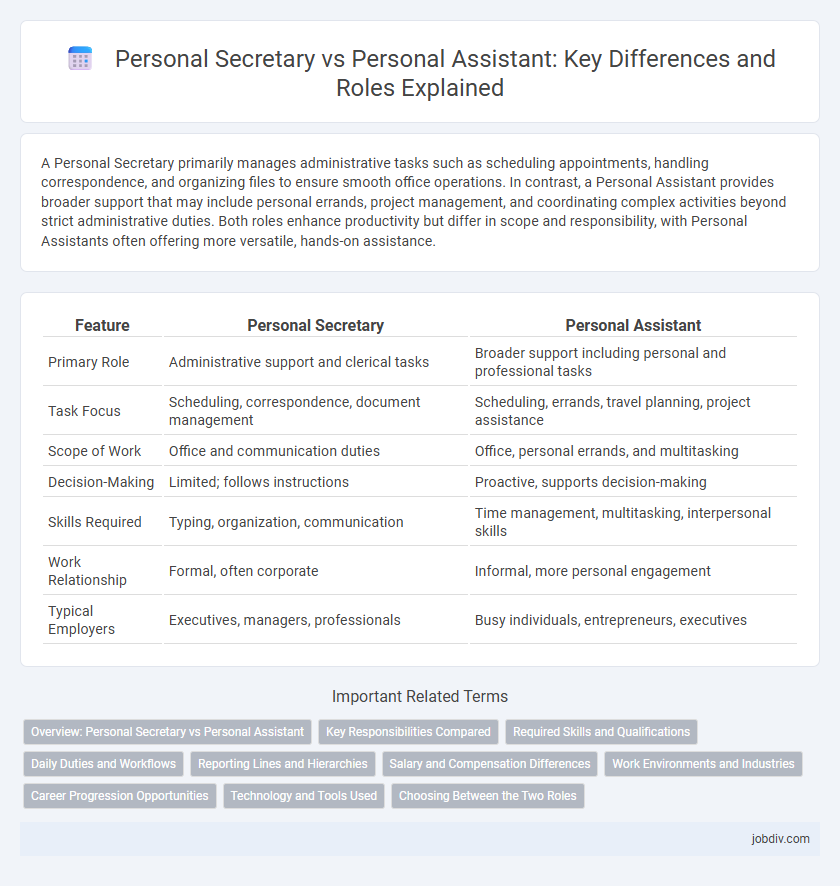A Personal Secretary primarily manages administrative tasks such as scheduling appointments, handling correspondence, and organizing files to ensure smooth office operations. In contrast, a Personal Assistant provides broader support that may include personal errands, project management, and coordinating complex activities beyond strict administrative duties. Both roles enhance productivity but differ in scope and responsibility, with Personal Assistants often offering more versatile, hands-on assistance.
Table of Comparison
| Feature | Personal Secretary | Personal Assistant |
|---|---|---|
| Primary Role | Administrative support and clerical tasks | Broader support including personal and professional tasks |
| Task Focus | Scheduling, correspondence, document management | Scheduling, errands, travel planning, project assistance |
| Scope of Work | Office and communication duties | Office, personal errands, and multitasking |
| Decision-Making | Limited; follows instructions | Proactive, supports decision-making |
| Skills Required | Typing, organization, communication | Time management, multitasking, interpersonal skills |
| Work Relationship | Formal, often corporate | Informal, more personal engagement |
| Typical Employers | Executives, managers, professionals | Busy individuals, entrepreneurs, executives |
Overview: Personal Secretary vs Personal Assistant
A Personal Secretary primarily handles administrative tasks such as scheduling appointments, managing correspondence, and organizing files, focusing on maintaining office efficiency. A Personal Assistant offers a broader range of support, often including personal errands, project management, and coordinating complex schedules, blending professional and personal responsibilities. Both roles require strong organizational skills, but the scope of a Personal Assistant's duties is typically more diverse and flexible.
Key Responsibilities Compared
A Personal Secretary primarily manages administrative tasks such as scheduling appointments, handling correspondence, and maintaining records to ensure smooth office operations. In contrast, a Personal Assistant takes on a broader role, including managing personal errands, coordinating complex travel plans, and supporting decision-making processes. Both positions require excellent organizational skills, but the Personal Assistant often engages in more strategic and personalized support.
Required Skills and Qualifications
A Personal Secretary requires strong organizational skills, proficiency in office software, and excellent communication abilities to manage schedules, correspondence, and documentation efficiently. A Personal Assistant demands broader multitasking skills, including problem-solving, discretion, and often project management expertise, to support executives with both administrative tasks and personal errands. Both roles typically require a high level of confidentiality, adaptability, and experience in time management, but a Personal Assistant may need additional qualifications such as familiarity with business operations and interpersonal skills.
Daily Duties and Workflows
Personal Secretaries primarily manage schedules, handle correspondence, and organize meetings, ensuring smooth daily operations for executives. Personal Assistants perform broader tasks including project management, travel arrangements, and client communications, supporting both professional and personal needs. Daily workflows of Personal Secretaries tend to be structured around administrative duties, while Personal Assistants adapt to dynamic tasks requiring multitasking and problem-solving skills.
Reporting Lines and Hierarchies
A Personal Secretary typically reports directly to a high-level executive and operates within a formal hierarchical structure, focusing on clerical tasks and calendar management. In contrast, a Personal Assistant often has a broader reporting line, supporting multiple stakeholders and handling diverse responsibilities that go beyond administrative duties. The hierarchy for Personal Assistants is generally flatter, emphasizing flexibility and multitasking across teams.
Salary and Compensation Differences
Personal secretaries typically earn an average salary ranging from $40,000 to $55,000 annually, while personal assistants often command higher compensation, averaging between $50,000 and $70,000 per year due to broader responsibilities. Salary disparities stem from variations in skill requirements, with personal assistants managing complex tasks such as scheduling, project coordination, and client communication. Bonus structures and benefits packages for personal assistants also tend to be more comprehensive, reflecting their expanded role in executive support.
Work Environments and Industries
Personal secretaries commonly work in corporate offices, law firms, and government agencies where structured administrative support and document management are critical. Personal assistants often operate in diverse environments including entertainment, healthcare, and entrepreneurial sectors, providing versatile support tailored to dynamic, high-pressure settings. Both roles demand adaptability but differ in industry focus and daily task complexity.
Career Progression Opportunities
Personal secretaries often have clear career progression paths within administrative and executive support roles, advancing to senior secretary or office manager positions. Personal assistants typically gain broader experience in project management and client relations, enabling transitions into higher roles such as executive assistant, operations manager, or even specialized consultancy. Both roles offer valuable opportunities, but personal assistants generally encounter more diverse career development options due to their varied responsibilities.
Technology and Tools Used
Personal Secretaries typically rely on traditional office software such as Microsoft Office Suite and basic scheduling tools, while Personal Assistants often utilize advanced technology including AI-driven task management apps, cloud-based collaboration platforms, and mobile productivity tools. The integration of digital assistants like Google Assistant or Siri enhances Personal Assistants' ability to manage communications and organize tasks efficiently in real-time. This technological leverage allows Personal Assistants to handle dynamic workflows and remote coordination more effectively than conventional Personal Secretaries.
Choosing Between the Two Roles
Choosing between a personal secretary and a personal assistant depends on the specific needs of the individual or executive. Personal secretaries typically handle administrative tasks such as scheduling, correspondence, and document management, providing essential organizational support. Personal assistants often take on a broader range of responsibilities, including project management, decision-making assistance, and personal errands, offering more comprehensive help.
Personal Secretary vs Personal Assistant Infographic

 jobdiv.com
jobdiv.com